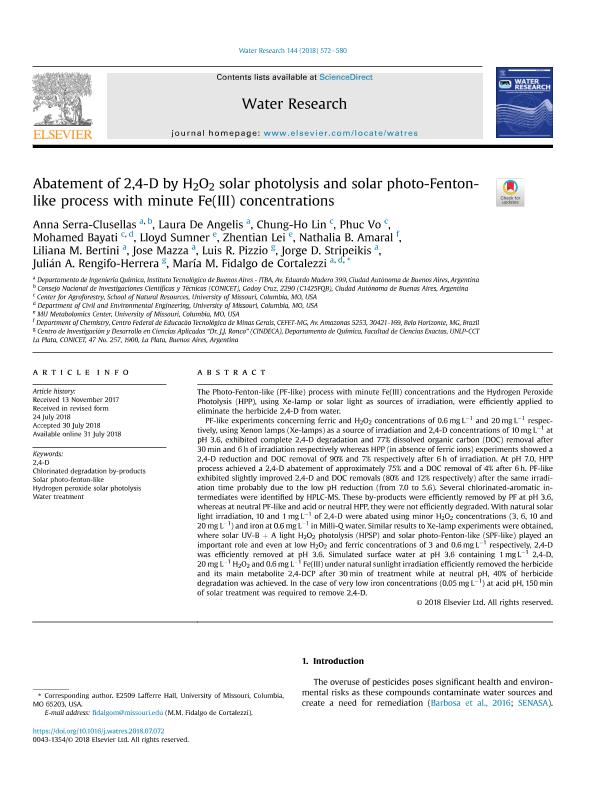Artículo
Abatement of 2,4-D by H2O2 solar photolysis and solar photo-Fenton-like process with minute Fe(III) concentrations
Serra Clusellas, Anna ; De Angelis, Laura; Lin, Chung Ho; Vo, Phuc; Bayati, Mohamed; Sumner, Lloyd; Lei, Zhentian; Amaral, Nathalia B.; Bertini, Liliana M.; Mazza, Jose; Pizzio, Luis Rene
; De Angelis, Laura; Lin, Chung Ho; Vo, Phuc; Bayati, Mohamed; Sumner, Lloyd; Lei, Zhentian; Amaral, Nathalia B.; Bertini, Liliana M.; Mazza, Jose; Pizzio, Luis Rene ; Stripeikis, Jorge Daniel; Rengifo Herrera, Julian Andres
; Stripeikis, Jorge Daniel; Rengifo Herrera, Julian Andres ; Fidalgo de Cortalezzi, Maria M.
; Fidalgo de Cortalezzi, Maria M.
 ; De Angelis, Laura; Lin, Chung Ho; Vo, Phuc; Bayati, Mohamed; Sumner, Lloyd; Lei, Zhentian; Amaral, Nathalia B.; Bertini, Liliana M.; Mazza, Jose; Pizzio, Luis Rene
; De Angelis, Laura; Lin, Chung Ho; Vo, Phuc; Bayati, Mohamed; Sumner, Lloyd; Lei, Zhentian; Amaral, Nathalia B.; Bertini, Liliana M.; Mazza, Jose; Pizzio, Luis Rene ; Stripeikis, Jorge Daniel; Rengifo Herrera, Julian Andres
; Stripeikis, Jorge Daniel; Rengifo Herrera, Julian Andres ; Fidalgo de Cortalezzi, Maria M.
; Fidalgo de Cortalezzi, Maria M.
Fecha de publicación:
11/2018
Editorial:
Pergamon-Elsevier Science Ltd
Revista:
Water Research
ISSN:
0043-1354
Idioma:
Inglés
Tipo de recurso:
Artículo publicado
Clasificación temática:
Resumen
The Photo-Fenton-like (PF-like) process with minute Fe(III) concentrations and the Hydrogen Peroxide Photolysis (HPP), using Xe-lamp or solar light as sources of irradiation, were efficiently applied to eliminate the herbicide 2,4-D from water. PF-like experiments concerning ferric and H2O2 concentrations of 0.6 mg L−1 and 20 mg L−1 respectively, using Xenon lamps (Xe-lamps) as a source of irradiation and 2,4-D concentrations of 10 mg L−1 at pH 3.6, exhibited complete 2,4-D degradation and 77% dissolved organic carbon (DOC) removal after 30 min and 6 h of irradiation respectively whereas HPP (in absence of ferric ions) experiments showed a 2,4-D reduction and DOC removal of 90% and 7% respectively after 6 h of irradiation. At pH 7.0, HPP process achieved a 2,4-D abatement of approximately 75% and a DOC removal of 4% after 6 h. PF-like exhibited slightly improved 2,4-D and DOC removals (80% and 12% respectively) after the same irradiation time probably due to the low pH reduction (from 7.0 to 5.6). Several chlorinated-aromatic intermediates were identified by HPLC-MS. These by-products were efficiently removed by PF at pH 3.6, whereas at neutral PF-like and acid or neutral HPP, they were not efficiently degraded. With natural solar light irradiation, 10 and 1 mg L−1 of 2,4-D were abated using minor H2O2 concentrations (3, 6, 10 and 20 mg L−1) and iron at 0.6 mg L−1 in Milli-Q water. Similar results to Xe-lamp experiments were obtained, where solar UV-B + A light H2O2 photolysis (HPSP) and solar photo-Fenton-like (SPF-like) played an important role and even at low H2O2 and ferric concentrations of 3 and 0.6 mg L−1 respectively, 2,4-D was efficiently removed at pH 3.6. Simulated surface water at pH 3.6 containing 1 mg L−1 2,4-D, 20 mg L−1 H2O2 and 0.6 mg L−1 Fe(III) under natural sunlight irradiation efficiently removed the herbicide and its main metabolite 2,4-DCP after 30 min of treatment while at neutral pH, 40% of herbicide degradation was achieved. In the case of very low iron concentrations (0.05 mg L−1) at acid pH, 150 min of solar treatment was required to remove 2,4-D.
Archivos asociados
Licencia
Identificadores
Colecciones
Articulos(CINDECA)
Articulos de CENTRO DE INV EN CS.APLICADAS "DR.JORGE J.RONCO"
Articulos de CENTRO DE INV EN CS.APLICADAS "DR.JORGE J.RONCO"
Citación
Serra Clusellas, Anna; De Angelis, Laura; Lin, Chung Ho; Vo, Phuc; Bayati, Mohamed; et al.; Abatement of 2,4-D by H2O2 solar photolysis and solar photo-Fenton-like process with minute Fe(III) concentrations; Pergamon-Elsevier Science Ltd; Water Research; 144; 11-2018; 572-580
Compartir
Altmétricas



